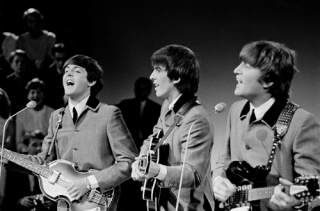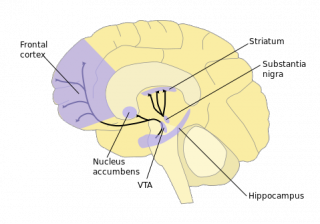Neuroscience
Love, Love Medulla: The Neuroscience of Beatlemania
Beatlemania: fainting, crying, and swooning? Neuroscience can explain why.
Posted February 6, 2014

The term “Beatlemania” has come to be associated with many things over the past half-century.
Coined in October 1963 during the Beatles’ tour of Scotland, the extent of Beatlemania in the United States is obvious by record sales alone. Between the 1964 release of “I Want to Hold Your Hand” on the Billboard Hot 100 and the Let it Be EP in 1970, the Lads from Liverpool had a Number One single for, on average, one out of every six weeks, and the top-selling album once every three weeks.
But to most, “Beatlemania” incites a vivid image of frenzied fans, predominantly teenage girls, looking as though they’ve just witnessed a gruesome murder. Fat buttons proclaiming “I LOVE GEORGE” adorn cardigan sweaters, hanging on for dear life as their owners attempt to push past overwhelmed human police barricades. Nurses stand at the ready, armed with smelling salts and ready to rouse the next fainting victim. Lots of tears. Lots of screaming.
As we approach the 50th anniversary of John, Paul, George, and Ringo’s first U.S. appearance on The Ed Sullivan Show this Sunday, we can’t help but look back and laugh nostalgically. Just what was it about the moptop haircuts, Cuban heels, and “yeah yeah yeah”s that turned us, our parents, or our grandparents into primeval beings whose sole purpose was to drown out the blare of a Vox AC30 amplifier?
As it turns out, neuroscience can (partially) explain the phenomenon.
Why do we like music?

One could easily argue that Beatles fanatics didn’t go to their shows to actually hear what was being played. Of course, record sales prove that, indeed, people enjoy Beatles tunes. What about music can make us tap our toes, lull babies to sleep, well up with emotion, dance in any style, or stir up furious mosh pits?
In short, music makes us feel good. In a 2001 study at McGill University, researchers Anne Blood and Robert Zatorre recruited ten individuals who had at least some formal music training. Each participant selected a song that, they claimed, consistently gave them chills. The researchers played a 90-second excerpt of their chosen song while the subject laid in a magnetic resonance imaging (MRI) machine, a device that measures brain activity by detecting changes in blood flow.
Compared to control (neutral) sounds, music that elicits physical and emotional changes resulted in activation of limbic, paralimbic, and midbrain regions. These areas are implicated in pleasure and reward, not unlike the neural pathways that recognize yummy food, addictive drugs, and sex.

In an extension to this study published last April, Zatorre's group used fMRI to scan the brains of 19 volunteers while they listened to the first 30 seconds of 60 songs they'd never heard before. Participants then rated how much they were willing to spend if they were to buy each song, from $0 to $2.
As it turns out, connections between a limbic system structure called the amygdala with the hippocampus (involved in learning and memory) as well as the prefrontal cortex (important for decision-making) could predict how much participants were willing to spend on each song.
The strength of these connections may partially explain why die-hard Metallica fans might completely shun hip-hop, while others may refuse to listen to anything but country. Music is a personal preference, and although we know that it brings us pleasure, that’s about the extent of our understanding.
What’s with all the crying and fainting?
Typically, we equate crying with sadness and fainting with illness.
The truth is, our brains are actually pretty dumb, and any sudden, strong emotion—from happiness to relief to stress—can elicit these vulnerable physical reactions.

Our autonomic nervous system (the "involuntary" nervous system) is divided into two branches: sympathetic ("fight-or-flight") and parasympathetic ("rest-and-digest"). Acting via the hypothalamus, the sympathetic nervous system is designed to mobilize the body during times of stress. It's why our heart rate quickens, why we sweat, why we feel ready to run. The parasympathetic nervous system, on the other hand, essentially calms us back down.
The parasympathetic nervous system does something funny, too. Connected to our lacrimal glands (better known as tear ducts), activation of parasympathetic receptors by the neurotransmitter acetylcholine results in tear production. So for those fans relieved to finally see their Fab Four, tears were commonplace.
For others, though, the sudden activation of their parasympathetic nervous system is accompanied by something much more dramatic. A quick drop in blood pressure results from vessels widening and heart rate slowing, hence the fainting.
Fainting, crying…exactly the things you’d want your hero to see you do when you finally meet them, right?
Every girl’s crazy ‘bout a sharp-dressed man
Let’s be honest—there’s a reason Beatlemania is typified by hoardes of young women. The Beatles looked good.
When Brian Epstein officially signed on as the Beatles’ manager in early 1962, the first thing he did was smarten up their stage appearance; he fitted them into Edwardian collarless suits, matching boots, and choreographed a synchronized bow at the end of each song.
According to a 2011 survey, 91% of Americans believe that a well-dressed man appears smarter, sexier, and more successful than one who is not, regardless of their overall physical attractiveness or how much money they have.

A 1990 University of Toledo study of 382 college students examined just how clothes can make the man. One “attractive” and one “unattractive” man (as previously determined by a panel of females) donned a variety of clothes—from designer watches and pressed shirts to baseball caps and Burger King polos. Consistently, women rated the well-dressed man as more attractive than the sloppier one, regardless of which model sported which ensemble.
The Beatles had some pretty great hair, too. Inspired by a man they saw during a gig in Hamburg, Germany, John and Paul reportedly hitchhiked to Paris and requested the distinctive haircut.
Across cultures, long, shiny female hair is rated attractive by both genders. Evolutionary psychologists reason that the ability to grow long hair can reveal several years of a person’s health status, age, nutrition, and reproductive fitness, as vitamin deficiencies result in hair loss.
Plus, the moptops eliminated any sign of androgenic alopecia, or male-pattern baldness, which studies have associated with perceived aging and less attractiveness. (Don’t worry, men; evolutionary biologists theorize that baldness is actually a sign of dominance, longevity, and social status due to its cause, a more potent form of testosterone called DHT.)
Although the fans may have drowned out the music with their shrieks, at least they still had a sight to behold.
---

Fifty years ago this Sunday, 73 million Americans crowded around 60% of the country’s televisions to watch the Beatles’ U.S. debut, signaling the birth of Beatlemania.It seems all the fainting, crying, and swooning can indeed be justified, to a degree.
But if you’re one of the crazed fans that loyally purchased (and wore) one of Lowell Toys’ “only AUTHENTIC Beatle Wigs,” your case may be beyond scientific explanation.
--
Originally published at The Conversation UK.
Image credit: Omroepvereniging VARA, SCA Svenska Cellulosa Aktiebolaget, NIDA (Wikimedia Commons).
Blood, A. and R.J. Zatorre. Intensely pleasurable responses to music correlate with activity in brain regions implicated in reward and emotion. PNAS 98(20): 11818-11823 (2001).
Mitchelson, F. Muscarinic receptor agonists and antagonists: Effects on ocular function. Handbook Exp Pharmacol 208: 263-298 (2012).
Salimpoor, V.N., I. van den Bosch, N. Kovacevic, A.R. McIntosh, A. Dagher, and R.J. Zatorre. Interactions between the nucleus accumbens and auditory cortices predict music reward value. Science 340: 216-219 (2013).
Townsend, J.M. and G.D. Levy. Effects of potential partners' physical attractiveness and socioeconomic status on sexuality and partner selection. Arch Sex Behav 19(2): 149-164 (1990).




